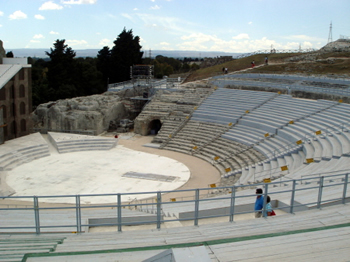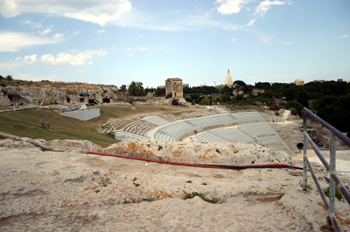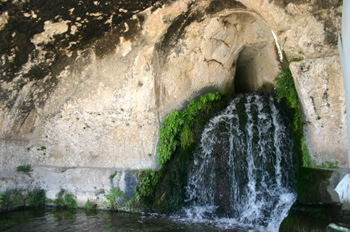
The Greek Theater of Syracuse.
The immense Greek theater admired today
in Syracuse (the largest in the Greek world of the Western Mediterranean)
is actually only part of the building founded in the 5th century B.C. and
rebuilt by Hieron
II in the 3rd century B.C.
The bases of some of the first-row seats
are still marked with the names and seat numbers of King
Hieron II and members of his
family.
Today what remains is, in fact, only the
lower part, which was dug directly into the rock, while all the rest was
built of stone blocks and colored marble (such as the top row of seats,
the covered portico that runs along the top, and the stage) and dismantled
by the Spanish
in the 16th century to build the fortifications of the island of Ortigia.
But even so, the remains are still of
an impressive grandeur, measuring 140 meters / 459
feet in
diameter and containing 67 rows of seats.
 |
| The theatron of the theater, as it appears during the season of performances of classical Greek plays. |
The space was used not only for the theater,
but also for public meetings.
Scholars do not agree on whether, in Roman
times and before the construction of the Arena,
it was also used to present fights between gladiators and animals.
The structure was built at the height of the "classic" era of ancient Greek theater, and none other than Aeschylus presented here in the 470s BC The Women of Aetna (now lost) and The Persians.
Tourists can admire the lower area of the orchestra and of the skene, of which relatively little remains and now partly occupied by a beautiful Mediterranean garden; the large middle part of the theatron (the rows of seats), which, despite everything, are still in a good state of preservation; and finally the top part, once occupied by a covered portico.
As mentioned previously, the theater has
lost its upper rows of seats, which were removed in the 16th century.
Still remaining are the theater’s good
acoustics, for which ancient theaters - built in an era when there were
no amplifiers - are famous.
 |
| The "little house" that stands out in this picture is the last of the watermills that once exploited the spring of the Grotto of the Nymph. |
Preserved at the upper part of the theater is the central structure (without blades) of one of the mills that were constructed in the 16th century, when the fountains of the Greek era (that of the Grotto of the Nymph) were reactivated, by exploiting the theater’s sloped construction.
The excavation of drainage channels and of a road to lead wagons to the mills inflicted further damage to the structure, which can still be seen.
Above the Theater
 |
| The so-called "Grotto of the Nymph,” a fountain that is more than 2,000 years old. |
Here a waterfall flows, which in ancient
times was surrounded by ancient statues of the Muses. This was a reference
to the mythical "Fountain
of the Muses", which according to legend turned those who drank
its water into poets.
It is no coincidence that the “Mouseion”
(that is the shrine of the Muses) was here the home of the actors guild.
The water channel (Galermi aqueduct)
dates back to the Greek era and was restored in the middle of the
16th century to start the watermills.
Today, of course, the ancient fountain
returns to being just a decorative element.
Along the cliff one notices a long series of square niches (naiskoi), which are all that remain of the "pinakes” (squares) containing religious images, which in Greek times were used for the worship of heroes (something resembling our concept of the "cult of the saints").
The images were usually painted, but could
also be made of wood or clay, cemented to the base of the naiskoi.
They were, in essence, sort of small religious
“altars”, of which only the niches cut into the rock now remain.
The road that runs along the rock wall
eventually proceeds, with a Cyclopean cut in the rock studded with naiskoi,
outward.
There one can still see the tracks carved
into the stone road by wagons over the centuries.
Cycle of performances of classical theater
at the Greek Theater in Syracuse.
Since 1914, the Greek theater in Syracuse
has been home to a Spring festival of classical Greek plays.
See
the dedicated page for more information.
How to Reach the Greek Theater from
the Algilà
Ortigia Charme Hotel.
The Greek theater belongs to the Archaeological
Park of Syracuse, which is located off the island of Ortigia
and more precisely at the extreme north of the ancient city (Neapolis).
A route by foot is possible, but it will exceed one kilometer
/ 0.62 miles in distance.
Those who do not have their own transportation
can call a taxi from the reception desk at a special rate or use the bicycles
that the Hotel Algilà offers to its guests for free.
Alternatively, one can take the (free)
shuttle bus #20 from the nearby Piazza
Archimede up to the bus station (near the train station) and
then take either one of the following bus lines: 6, 8, 11, 12 or
13.
Otherwise, from Riva Nazario Sauro (behind
the nearby Piazza delle Poste) one can choose from the following bus lines
1, 2, 3, 4 or 12.
Visitor Information.
All of the sights within the Archaeological
Park can be visited with a single ticket of entry (full price € 6, with
reduced-priced tickets available for those aged 18 to 25 years and free
entry for citizens of the European Union under 18 or over 65). Remember
not to throw away the ticket to go from one area to another.
Admission is free for people with disabilities
and for those who accompany them.
Note: During the period in which
the
cycle of performances of classical theater is presented (May/June),
the lower part of the theatron and the skene of the Greek
Theater are not accessible.
The park is open every day, including holidays,
from 9:00 a.m. until two hours before sunset.
Because of the enormous quantity of sights
worth visiting in the Archeological Park and the extensive size of the
area, one should plan to spend at least an hour and a half for a
leisurely visit.
The area is organized in such a way as to be accessible from a convenient road, which is easy to follow even for those who have difficulty walking, but there is not a complete absence of architectural barriers given that some areas are accessible only by stairs.
Back to TOURISM IN SYRACUSE, SICILY